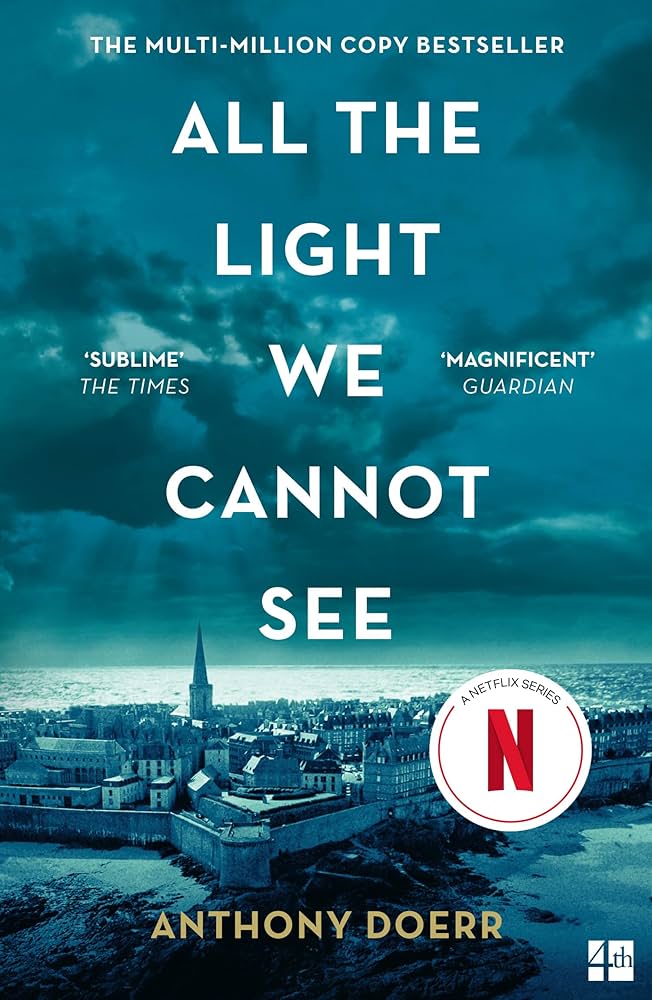
All the Light We Cannot See
Fort National
by Anthony, Doerr,The chapter “Fort National” depicts a harrowing moment during the siege of Saint-Malo, where the relentless shelling suddenly pauses, creating an eerie calm. Amidst the chaos, the city burns—trees, cars, and houses engulfed in flames. German soldiers take refuge in blockhouses, drinking wine, while a priest attempts to bless the cellar walls of a college. The tension is further heightened by two terrified horses breaking free and galloping through the smoke-filled streets, symbolizing the unchecked fear and destruction sweeping the city.
As the afternoon progresses, the narrative shifts to a tragic mishap involving an American field howitzer. A single misfired shell, improperly ranged, arcs over the city walls and strikes Fort National, where 380 French prisoners are held with little protection. The explosion kills nine men instantly, their lives abruptly ended in the midst of mundane activities, such as a card game. This moment underscores the brutal randomness of war, where even a misplaced shell can have devastating consequences.
The chapter vividly contrasts the surreal quiet of the lull in shelling with the sudden violence of the errant explosion. The imagery of burning structures and frantic animals paints a picture of a city on the brink, while the fate of the prisoners at Fort National highlights the human cost of military errors. The juxtaposition of ordinary moments, like drinking wine or playing cards, against the backdrop of war emphasizes the fragility of life in such times.
Ultimately, “Fort National” serves as a poignant snapshot of the siege, capturing both the tension and tragedy of war. The brief respite in shelling only amplifies the horror of the subsequent explosion, illustrating how quickly peace can shatter. Through its vivid descriptions and emotional weight, the chapter underscores the indiscriminate nature of conflict and its profound impact on both the landscape and the people caught within it.
FAQs
1. What is the setting and situation described at the beginning of the chapter?
Answer:
The chapter opens during the siege of Saint-Malo, specifically on the third afternoon when the shelling temporarily subsides. The scene depicts a war-torn environment with burning trees, cars, and houses. German soldiers are drinking wine in blockhouses, a priest is blessing a cellar, and panicked horses escape their enclosure to run through the smoldering streets. This establishes a chaotic, tense atmosphere of a city under attack, where both human and animal inhabitants are affected by the violence and destruction.2. What happens when the American field howitzer fires an improperly ranged shell?
Answer:
The misfired shell from the American howitzer overshoots its target and strikes Fort National’s northern parapet, where 380 French prisoners are being held with little protection. The explosion kills nine men instantly—one of whom is still holding playing cards from a bridge game when he dies. This tragic accident highlights the indiscriminate nature of war, where even misplaced artillery can have devastating consequences for civilians and prisoners.3. How does the author use contrasting imagery to depict the siege?
Answer:
The chapter juxtaposes moments of eerie calm (“as though all the artillerymen abruptly fell asleep”) with violent destruction (“Trees burn, cars burn, houses burn”). The image of German soldiers casually drinking wine contrasts with the frantic horses and the priest performing last rites. These contrasts emphasize the surreal, unpredictable nature of war—where routine activities and sudden terror coexist, and both humans and animals are driven to extremes.4. Why might the author include the detail about the prisoner still clutching his cards?
Answer:
This detail underscores the abruptness and brutality of war. The man’s death mid-game symbolizes how ordinary life is violently interrupted—even mundane moments like playing cards can be cut short. It also humanizes the victims, making their loss more poignant. By focusing on this small, personal detail, the author invites readers to reflect on the individual lives affected by large-scale conflict, rather than seeing casualties as mere statistics.5. What broader themes does this chapter introduce about war?
Answer:
The chapter illustrates war’s chaos and collateral damage: the misfired shell represents the lack of control in conflict, while the burning city and imprisoned civilians show its widespread impact. Themes of futility (the priest’s blessings amid destruction) and disrupted normality (the bridge game cut short) emerge. The passage suggests that war spares no one—combatants, prisoners, animals, and even spiritual figures are all caught in its devastation, with moments of false calm heightening the sense of unpredictability.
Quotes
1. “On the third afternoon of the siege of Saint-Malo, the shelling lulls, as though all the artillerymen abruptly fell asleep at their guns.”
This opening line sets the eerie, suspended atmosphere of the siege, contrasting the violence of war with an unnatural quiet. It foreshadows the sudden brutality that follows.
2. “Trees burn, cars burn, houses burn. German soldiers drink wine in blockhouses.”
This stark juxtaposition captures the surreal duality of war—destruction and normalcy coexisting. It emphasizes the indifference of some soldiers amid the chaos.
3. “An American field howitzer, two miles away, lets fly a single improperly ranged shell. It sails over the city walls and bursts against the northern parapet of Fort National, where three hundred and eighty Frenchmen are being held against their will with minimal cover.”
This quote marks a tragic turning point, highlighting the indiscriminate nature of war and its collateral damage. The “improperly ranged” detail underscores the senselessness of the violence.
4. “Nine are killed instantly. One of them still clutching the hand of bridge he was playing when the shell struck.”
The visceral detail of the bridge player emphasizes the abruptness of death in war and the fragility of ordinary moments amid conflict. It personalizes the tragedy.
